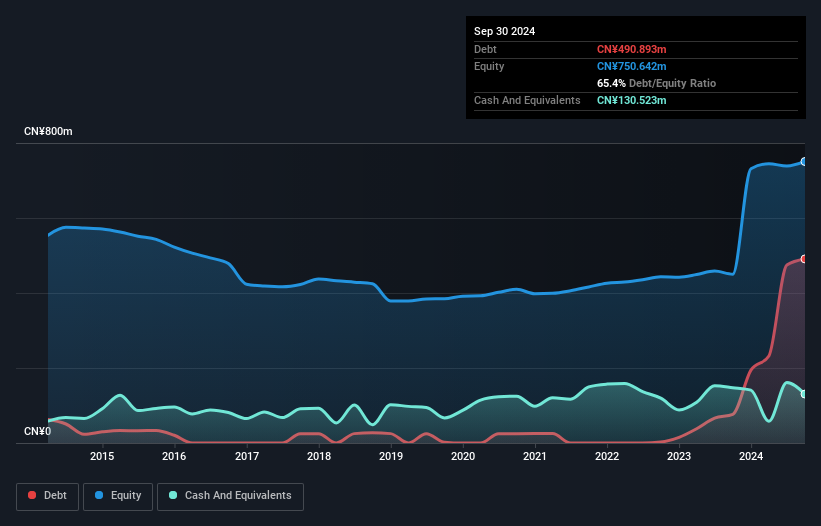Legendary fund manager Li Lu (who Charlie Munger backed) once said, 'The biggest investment risk is not the volatility of prices, but whether you will suffer a permanent loss of capital.' When we think about how risky a company is, we always like to look at its use of debt, since debt overload can lead to ruin. We note that Tianjin Printronics Circuit Corporation (SZSE:002134) does have debt on its balance sheet. But the more important question is: how much risk is that debt creating?
When Is Debt Dangerous?
Generally speaking, debt only becomes a real problem when a company can't easily pay it off, either by raising capital or with its own cash flow. In the worst case scenario, a company can go bankrupt if it cannot pay its creditors. However, a more frequent (but still costly) occurrence is where a company must issue shares at bargain-basement prices, permanently diluting shareholders, just to shore up its balance sheet. By replacing dilution, though, debt can be an extremely good tool for businesses that need capital to invest in growth at high rates of return. When we think about a company's use of debt, we first look at cash and debt together.
What Is Tianjin Printronics Circuit's Debt?
You can click the graphic below for the historical numbers, but it shows that as of September 2024 Tianjin Printronics Circuit had CN¥490.9m of debt, an increase on CN¥76.3m, over one year. However, it does have CN¥130.5m in cash offsetting this, leading to net debt of about CN¥360.4m.

How Healthy Is Tianjin Printronics Circuit's Balance Sheet?
 Zooming in on the latest balance sheet data, we can see that Tianjin Printronics Circuit had liabilities of CN¥717.4m due within 12 months and liabilities of CN¥486.7m due beyond that. On the other hand, it had cash of CN¥130.5m and CN¥408.6m worth of receivables due within a year. So it has liabilities totalling CN¥664.9m more than its cash and near-term receivables, combined.
Zooming in on the latest balance sheet data, we can see that Tianjin Printronics Circuit had liabilities of CN¥717.4m due within 12 months and liabilities of CN¥486.7m due beyond that. On the other hand, it had cash of CN¥130.5m and CN¥408.6m worth of receivables due within a year. So it has liabilities totalling CN¥664.9m more than its cash and near-term receivables, combined.
Since publicly traded Tianjin Printronics Circuit shares are worth a total of CN¥4.30b, it seems unlikely that this level of liabilities would be a major threat. But there are sufficient liabilities that we would certainly recommend shareholders continue to monitor the balance sheet, going forward.
We measure a company's debt load relative to its earnings power by looking at its net debt divided by its earnings before interest, tax, depreciation, and amortization (EBITDA) and by calculating how easily its earnings before interest and tax (EBIT) cover its interest expense (interest cover). This way, we consider both the absolute quantum of the debt, as well as the interest rates paid on it.
Tianjin Printronics Circuit's debt is 3.9 times its EBITDA, and its EBIT cover its interest expense 6.6 times over. Taken together this implies that, while we wouldn't want to see debt levels rise, we think it can handle its current leverage. It is well worth noting that Tianjin Printronics Circuit's EBIT shot up like bamboo after rain, gaining 63% in the last twelve months. That'll make it easier to manage its debt. The balance sheet is clearly the area to focus on when you are analysing debt. But you can't view debt in total isolation; since Tianjin Printronics Circuit will need earnings to service that debt. So if you're keen to discover more about its earnings, it might be worth checking out this graph of its long term earnings trend.
Finally, a business needs free cash flow to pay off debt; accounting profits just don't cut it. So it's worth checking how much of that EBIT is backed by free cash flow. During the last three years, Tianjin Printronics Circuit burned a lot of cash. While investors are no doubt expecting a reversal of that situation in due course, it clearly does mean its use of debt is more risky.
Our View
Tianjin Printronics Circuit's conversion of EBIT to free cash flow was a real negative on this analysis, although the other factors we considered were considerably better. In particular, we are dazzled with its EBIT growth rate. When we consider all the factors mentioned above, we do feel a bit cautious about Tianjin Printronics Circuit's use of debt. While debt does have its upside in higher potential returns, we think shareholders should definitely consider how debt levels might make the stock more risky. The balance sheet is clearly the area to focus on when you are analysing debt. However, not all investment risk resides within the balance sheet - far from it. For example - Tianjin Printronics Circuit has 3 warning signs we think you should be aware of.
Of course, if you're the type of investor who prefers buying stocks without the burden of debt, then don't hesitate to discover our exclusive list of net cash growth stocks, today.
Have feedback on this article? Concerned about the content? Get in touch with us directly. Alternatively, email editorial-team (at) simplywallst.com.
This article by Simply Wall St is general in nature. We provide commentary based on historical data and analyst forecasts only using an unbiased methodology and our articles are not intended to be financial advice. It does not constitute a recommendation to buy or sell any stock, and does not take account of your objectives, or your financial situation. We aim to bring you long-term focused analysis driven by fundamental data. Note that our analysis may not factor in the latest price-sensitive company announcements or qualitative material. Simply Wall St has no position in any stocks mentioned.

